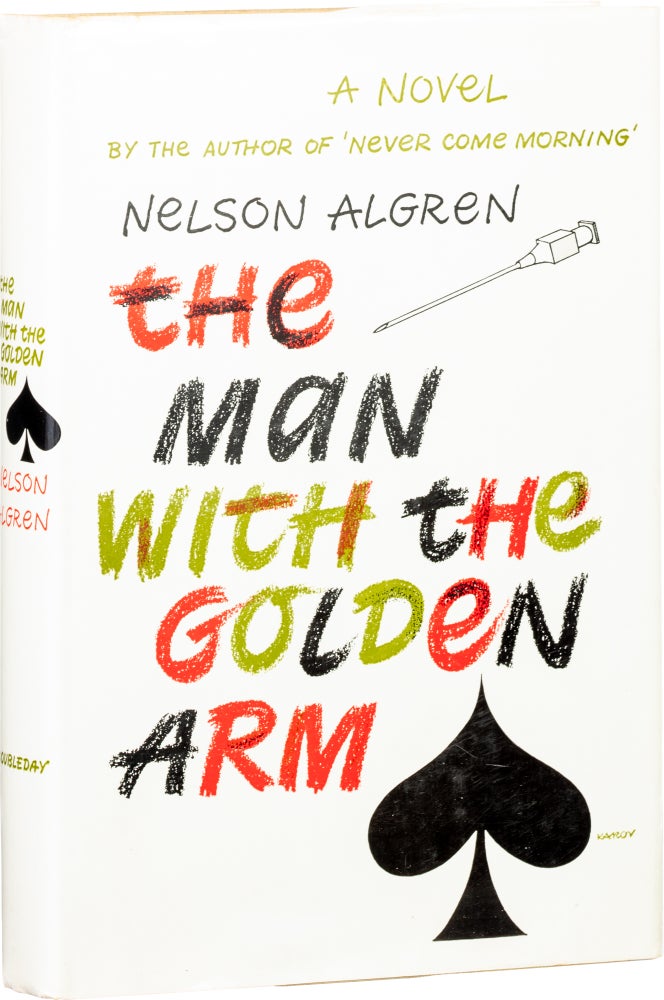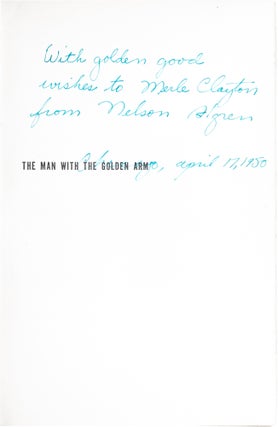The Man With the Golden Arm
Garden City: Doubleday, 1949. First Edition. Hardcover. 1st edition. Fine in fine dustjacket. A flawless jacket and others aren’t, so ignoring condition standards cuts a channel into which falls all other reasoning. Signed presentation copy, penned in ink on the half–title, “With golden good wishes to Merle Clayton from Nelson Algren. Chicago, April 17, 1950.” A National Book Award winner but the avalanche of awards these days has rendered them almost meaningless. Even more pathetic are 21st century dustjackets carrying the feeble pretension, “nominated for the X award.”. Fine / fine. Item #418
“Never play cards with a man called Doc. Never eat at a place called Mom’s. Never sleep with a woman whose troubles are worse than your own.” –N. Algren
This’s as good a place as any to define the differences between presentation copies, inscribed ones, and those that are just signed, and then prioritize them, but it’ll have to be simplified in a commercial catalog of 100 pages. Definitions first: 1. A presentation copy was a gift from the author with some gist in the author’s handwriting upholding the seller’s premise that a gift is what it was. It may be signed with the author’s full name, or in closer relationships only a first name, or may say “from the author” as was frequently the taste pre–20th century. If it’s dated within a year or so of publication, then it is a contemporary presentation copy. There’re also publisher’s presentations (a lesser species when deciding value), whether prompted by the publisher, or directed by the author to a specific recipient, but the signs are, or the handwriting is, by the publisher or a secretary, and few were ever within the author’s proximity. 2. Inscribed copies have writing in the author’s hand beyond an autograph but were not given as a gift. 3. And signed copies are just that. I am spurning books signed by someone else, though a book with, a gift inscription from, or the ownership signature of, George Washington, or Marilyn Monroe, or D. B. Cooper, has its own cache and value, but laid in signatures are a hoax. Now for the hierarchy. Presentation copies are usually worth more than inscribed ones, and should be, either because the link between author and recipient is interesting, or was close, or the recipient is a luminary, whether for literary fame or something else. The “usually” is because it is easy to reckon that a pithy presentation copy, given to an author’s neighbor out of courtesy, would not be as valuable as a copy inscribed to nobody when the inscription is a 50 word quotation from the book. And both presentation copies and inscribed copies are more valuable than generic signed ones as more handwriting supports genuineness, since it is much easier to convincingly forge a signature than additional words of handwriting, and simple autographs are exactly what are broadly counterfeited beyond the detection of experts because a skilled and practiced forger knows all the tells that an authenticator looks for. So, these validation experts solely reject fakes done by innocent secretaries or incompetent villains, and their certificates of authenticity transfer less real weight than an empty wind tunnel, before dawn, quietly waiting for work (Book Code).
Price:
$800.00


